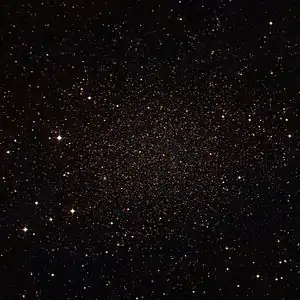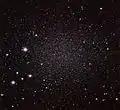Sculptor Dwarf Galaxy
The Sculptor Dwarf Galaxy (also known as Sculptor Dwarf Elliptical Galaxy or the Sculptor Dwarf Spheroidal Galaxy, and formerly as the Sculptor System) is a dwarf spheroidal galaxy that is a satellite of the Milky Way. The galaxy lies within the constellation Sculptor. It was discovered in 1937 by American astronomer Harlow Shapley using the 24-inch Bruce refractor at Boyden Observatory.[4][5] The galaxy is located about 290,000 light-years away from the Solar System. The Sculptor Dwarf contains only 4 percent of the carbon and other heavy elements in our own galaxy, the Milky Way, making it similar to primitive galaxies seen at the edge of the universe.[6]
| Sculptor Dwarf Elliptical Galaxy | |
|---|---|
 | |
| Observation data (J2000 epoch) | |
| Constellation | Sculptor |
| Right ascension | 01h 00m 09.3s[1] |
| Declination | −33° 42′ 33″[1] |
| Redshift | 110 ± 1 km/s[1] |
| Distance | 290 ± 30 kly (90 ± 10 kpc)[2][3] |
| Apparent magnitude (V) | 10.1[1] |
| Characteristics | |
| Type | E[1] |
| Apparent size (V) | 39′.8 × 30′.9[1] |
| Other designations | |
| Sculptor Dwarf Spheroidal,[1] PGC 3589,[1] MCG-06-03-015 | |
Metallicity
The metallicity of Sculptor dwarf appears to be broken up into two distinct groups, one with [Fe/H] = -2.3 and the other with [Fe/H] = -1.5.[7] Similar to many of the other Local Group galaxies, the older metal-poor segment appears more extended than the younger metal-rich segment.[8]
Measurements
Using both Hubble Telescope and Gaia observations 12 years apart, about 100 stars in the galaxy were mapped accurately, and 3D motions of about 10 of those stars enable trajectories to be mapped as well.[9]
Gallery
 Sculptor Dwarf Galaxy taken by the 2.2-meter MPG/ESO telescope.[10]
Sculptor Dwarf Galaxy taken by the 2.2-meter MPG/ESO telescope.[10]
References
- "NASA/IPAC Extragalactic Database". Results for PGC 3589. Retrieved 2006-12-03.
- I. D. Karachentsev; V. E. Karachentseva; W. K. Hutchmeier; D. I. Makarov (2004). "A Catalog of Neighboring Galaxies". Astronomical Journal (abstract). 128 (4): 2031–2068. Bibcode:2004AJ....127.2031K. doi:10.1086/382905.
- Karachentsev, I. D.; Kashibadze, O. G. (2006). "Masses of the local group and of the M81 group estimated from distortions in the local velocity field". Astrophysics. 49 (1): 3–18. Bibcode:2006Ap.....49....3K. doi:10.1007/s10511-006-0002-6.
- Shapley, H., (1938) Harvard Bull. 908.
- Shapley H (1938). "Two Stellar Systems of a New Kind". Nature. 142 (3598): 715–6. Bibcode:1938Natur.142..715S. doi:10.1038/142715b0.
- Astronomers Detect Dust Around a Primitive Star, Shedding New Light on Universe’s Origins Newswise, Retrieved on January 19, 2008.
- S.R. Majewski; et al. (20 July 1999). "An Internal Second-Parameter Problem in the Sculptor Dwarf Spheroidal Galaxy". The Astrophysical Journal. 520 (1). arXiv:astro-ph/9905238. Bibcode:1999ApJ...520L..33M. doi:10.1086/312133.
- van den Bergh, Sidney (April 2000). "Updated Information on the Local Group". The Publications of the Astronomical Society of the Pacific. 112 (770): 529–536. arXiv:astro-ph/0001040. Bibcode:2000PASP..112..529V. doi:10.1086/316548.
- Hubble and Gaia team up to measure 3D stellar motion with record-breaking precision
- "Sculptor Dwarf Galaxy". Retrieved 17 September 2015.
External links
| Wikimedia Commons has media related to Sculptor Dwarf Galaxy. |
- The Sculptor Dwarf Galaxy on WikiSky: DSS2, SDSS, GALEX, IRAS, Hydrogen α, X-Ray, Astrophoto, Sky Map, Articles and images
